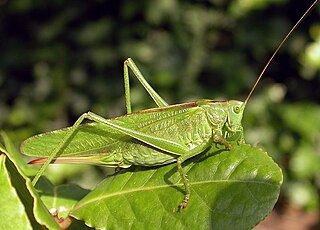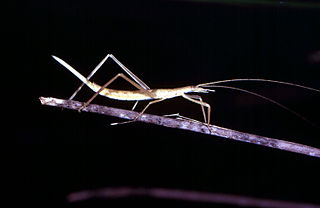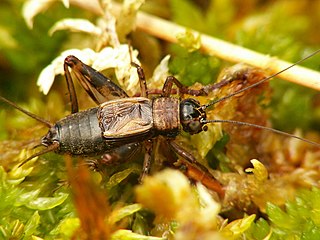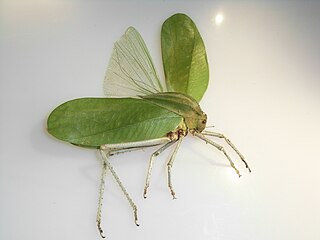
The Cooloola monster is a large burrowing orthopteran of the family Cooloolidae, a family erected to accommodate it because it is so dissimilar to other ensiferans. It was discovered in 1980 in the Great Sandy National Park in Queensland, Australia, by David C. Rentz. Further members of the genus Cooloola were later discovered at other locations in Queensland.

Cooloola is a genus of ensiferan orthopterans known as Cooloola monsters. It is the only genus in the subfamily Cooloolinae and family Cooloolidae of the superfamily Stenopelmatoidea.

Stenopelmatidae is a family of large, mostly flightless orthopterans that includes the Jerusalem crickets. Two genera: Ammopelmatus and the type genus Stenopelmatus are found in the New World. Oryctopus and Sia are Old World genera, and previously placed in their own subfamilies, but with the addition of new genera, current placement is as five tribes in the single subfamily Stenopelmatinae.

The Tettigoniinae are a subfamily of bush crickets or katydids, which contains hundreds of species in about twelve tribes.

The Phasmatidae are a family of the stick insects. They belong to the superfamily Anareolatae of suborder Verophasmatodea.
Ixalodectes is a genus of Australian bush crickets.

Kawanaphila is a genus of insects in family Tettigoniidae from Australia. It was described in 1993 by David C. Rentz.

Jerusalem crickets are a group of large, flightless insects in the genera Ammopelmatus and Stenopelmatus, together comprising the tribe Stenopelmatini. The former genus is native to the western United States and parts of Mexico, while the latter genus is from Central America.

The Phaneropterinae, the sickle-bearing bush crickets or leaf katydids, are a subfamily of insects within the family Tettigoniidae. Nearly 2,060 species in 85 genera throughout the world are known. They are also known as false katydids or round-headed katydids.

Gryllacridinae is an Orthopteran subfamily in the family Gryllacrididae.
Phyllophorella queenslandica is a species of bush crickets or katydids described in 2009. It is commonly known as the Small Hooded Katydid or Queensland Small Hooded Katydid. The species is native to Far North Queensland, from Kuranda to the Lockerbie area.

Mecopodinae are a subfamily of bush crickets found in western South America, sub-Saharan Africa, and Asia. In Asia, the distribution includes India, Indochina, Japan, the Philippines, and Malesia to Papua New Guinea and Australasia, including many Pacific islands.

Nemobiinae is a subfamily of the newly constituted Trigonidiidae, one of the cricket families. The type genus is Nemobius, which includes the wood cricket, but members of this subfamily may also be known as ground crickets or "pygmy field crickets".

Conocephalinae, meaning "conical head", is an Orthopteran subfamily in the family Tettigoniidae.

Agraeciini is a large tribe of bush crickets or katydids in the conehead subfamily, Conocephalinae.

Zaprochilinae is a subfamily of bush-crickets found in Australia; the type genus is Zaprochilus.

The Listroscelidinae are a subfamily of the Tettigoniidae found in the Americas, Madagascar, and Australia.

Caedicia is a genus of bush crickets or katydids in the subfamily Phaneropterinae. Species can be found Australasia, with records from Vietnam, Papua New Guinea, and Australia.
Alinjarria elongata, commonly known as the territory imitator, is a species of bush-cricket from tropical northern Australia. The common name is derived from the fact that the species was at first thought to be a member of the genus Hemisaga until it was realised that its unique characteristics warranted placing it in a new genus.

Siliquofera is a genus of bush cricket in the subfamily Phyllophorinae that includes only one species, Siliquofera grandis, which is fairly common and widespread in rainforest canopies of New Guinea and nearby smaller islands, and seemingly rare in Australia where only found in the remote Iron Range region. This very well-camouflaged, green and leaf-like bush cricket is one of the world's largest Orthoptera, with adults typically having a length of 10.7–13 cm (4.2–5.1 in) and a wingspan of 25–27 cm (9.8–10.6 in); it can weigh more than 30 g (1.1 oz).














